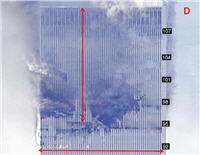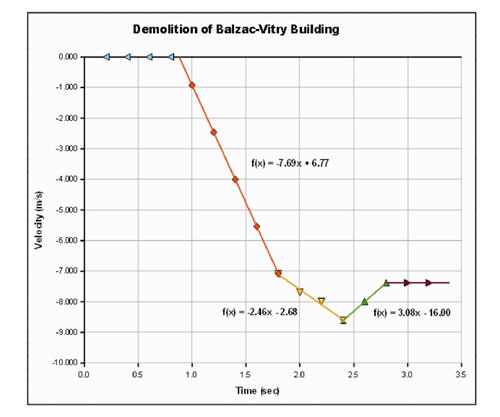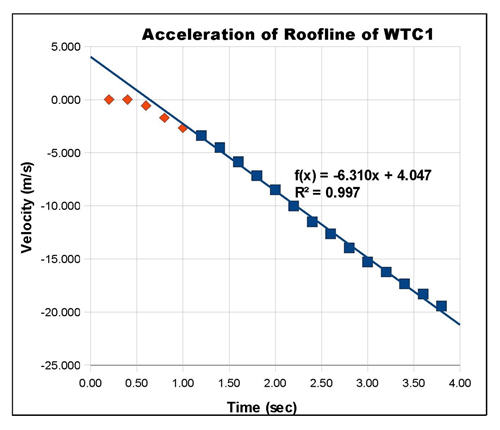
© Unknown
Many people who think they have been keeping up with the revelations of the last several years about the destruction of the three high-rises in New York City on Sept. 11, 2001, will nonetheless be surprised to discover that the falling upper section of WTC 1 exhibited no measurable deceleration when it impacted the lower section. This is a startling revelation because it adds to the collection of "smoking guns" proving that the "collapse" of that building was not caused by the jetliner impact and ensuing fires.
Although theoretically possible, collapses of heavily constructed buildings like the Twin Towers and WTC 7 had never occurred prior to Sept. 11, 2001, without some form of "assistance." The reason for this is that they are built with significant reserve strength. The construction of each floor is designed to support several times the actual load above it.
The only way a collapse of a structure with significant reserve strength can continue is for the static load to be amplified in what is called dynamic loading. Dynamic loading occurs when the impacting object decelerates faster than the acceleration of gravity. For instance, if during an impact the falling object decelerates at three times the rate of gravity, it will impart a load on the object it strikes that is three times its static load. Dynamic loading was postulated in a paper used in the NIST report on the WTC collapses, written by Dr. Zdenek Bazant of Northwestern University. However, Dr. Bazant had not performed any actual measurements to support his theory.
Actual measurements of the descent of WTC 1 were performed independently in 2008 by physics instructor David Chandler of Fresno, California, and Professor Graeme MacQueen of Hamilton, Ontario. Both found no evidence of deceleration at any time during the descent. In fact the upper section of WTC 1 continuously accelerated, at approximately 2/3 of g (free-fall) during the first several seconds of the building's "collapse."
The contradiction caused by the lack of deceleration of the upper section of WTC 1 with the dynamic loading event postulated, but never measured, by Dr. Bazant or NIST, is discussed in a published paper entitled
"The Missing Jolt," which can be found online at the
Journal of 9/11 Studies and in the
Technical Articles section of the AE911Truth website.
Proof that the necessary deceleration is observable in a collapse in which the momentum and kinetic energy of an upper section break the columns in the lower section is found in the demolition of several buildings in France. In recent years demolition engineers there have devised a system known as the Verinage technique, where they demolish buildings without the use of explosives. This technique uses hydraulic rams to break all of the columns in a couple of stories near the center of the building. The loss of vertical support in these stories then causes the upper section to fall unimpeded through a pre-determined distance before impacting the intact lower structure. Watch this video of one of these demolitions - of the
Balzac-Vitry building.
In every instance of these "Verinage"-demolished buildings, measurement of the descent of the roofline shows definitive proof of deceleration of their upper sections as they impact the lower structure, as seen in the velocity graph of the Balzac-Vitry building demolition below.

© Unknown
Now compare the above velocity graph of the Balzac-Vitry demolition to the velocity graph of the WTC 1 "collapse."

© Unknown
The same measurement methodology is used in both cases.
There is obviously no deceleration in the fall of the upper section of WTC 1. A "natural" collapse (without the use of explosives) could not have occurred without it. Therefore, this verified scientific data proves that explosives must have been employed to remove the structural columns - and thus to bring down the World Trade Center North Tower.
It stands to reason that if the North Tower was brought down surreptitiously with explosives, then the South Tower must have been as well. Its destruction was similarly explosive, rapid, and thorough, though with few differences in the features of its destruction (which do not change the general argument).
Some excellent video footage shows experiments and provides additional discussion on why the lack of deceleration by WTC 1's upper section could not have been caused by simple overload of columns - even though several may have ben "cut" by the jetliner impact and others weakened by the ensuing fires. Professional engineer Jonathan Cole and David Chandler have recently produced several brief but cogent videos on the subject:
9/11 Experiments: Collapse vs. Demolition ~ Part 1 of 29/11 Experiments: Collapse vs. Demolition ~ Part 2 of 29/11 Experiments: Newton vs. NISTWhat a Gravity-Driven Demolition Looks Like
Theory of atomic bomb demolition.
[Link]
If the theory is correct it makes a lot of sense as to why there was no deceleration to the upper floors.